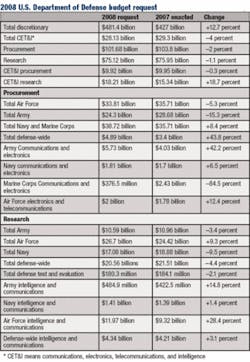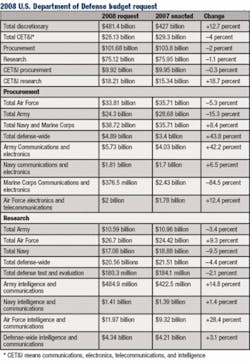DOD electronics spending to drop along with overall decline in procurement
By John Keller
WASHINGTON - Leaders of the U.S. Department of Defense (DOD) propose spending slightly more than $28.1 billion in fiscal year 2008 for procurement and research in communications, electronics, telecommunications, and intelligence (CET&I) technologies, which would represent a 4 percent decrease from current-year levels.
This amount does not include electronics-heavy activities such as avionics, vetronics, and missile guidance; when these are added, DOD spending levels for electronics and electro-optics could approach $60 billion, industry analysts believe.
Experts estimate that total DOD electronics, electro-optics, and information technology spending is roughly 15 percent of the total DOD budget. Most of the DOD’s technology spending is in the procurement, research, and development accounts.
For 2008, which begins next Oct. 1, DOD leaders overall are asking Congress for $481.4 billion in discretionary spending, which would be a 14.8 percent increase over the 2007 request of $419.3 billion and a 12.7 percent increase over 2007 congressional defense appropriations of $427 billion, DOD officials say.
The DOD’s proposed $481.4 billion discretionary spending budget includes proposals for military personnel, military construction, and family housing. These numbers do not include supplemental congressional appropriations to fund the global war on terrorism.
In addition, DOD leaders are asking Congress for $141.7 billion to fund the global war on terror, and $93.4 billion for emergency supplemental funding to pay for military operations in Iraq and Afghanistan, bringing the total 2008 military spending request to $716.5 billion.
For procurement, DOD is asking Congress for $101.68 billion, which is down 2.1 percent from current-year procurement spending of $103.81 billion. For research and development, DOD proposes to spend $75.1 billion in 2008, which is down 1.2 percent from current-year spending of $76 billion.
With DOD’s 2008 budget proposal submitted in early February, it now is up to Congress to authorize or reject the military’s spending proposals. With a Democratic congress in place for the first time in more than a decade, DOD will be hard-pressed to achieve its spending goals next year.
Air Force spending
The U.S. Air Force, which spends the most, by far, of any U.S. military service on electronics and electro-optics, is proposing to spend nearly $14 billion in 2008 for communications, electronics, telecommunications, and intelligence procurement and research-a 26.6 percent increase over current-year appropriations of $11.06 billion.
The Air Force’s budget request includes $2 billion to procure electronics and telecommunications equipment-an 11.1 percent increase over current spending of $1.8 billion, and $11.97 billion for research into intelligence and communications-a 28.4 percent increase over the 2007 level of $9.32 billion.
In total, the Air Force next year plans to spend $33.81 billion for procurement, and $26.71 billion on research and development.
Highlights of the Air Force’s technology procurement requests include $323.3 million for base information infrastructure, $208.9 million for tactical communications and electronics equipment, $180.2 million for communications security equipment, and $116.9 million for space-based military satellite communications systems.
Air Force researchers next year propose to spend $963.6 million on the Transformational Satellite Communications (TSAT) program, $587.2 million on the NAVSTAR global positioning system III, $603.9 million on the space-based Advanced EHF military satellite communications system, $587 million on the Space-Based Infrared System (SBIRS) High, and $1.78 billion on the Joint Strike Fighter.
Army spending
The U.S. Army is proposing to spend $6.21 billion for CET&I procurement and research-a 39.6 percent increase from current-year spending levels of $4.45 billion.
The Army’s budget request includes $5.7 billion for CET&I procurement-a 43 percent increase from current levels of $4 billion, and $484.9 million for related research and development-a 14.8 percent increase from the current level of $422.5 million.
In total, the Army next year plans to spend $24.3 billion on procurement and nearly $10.6 billion on research and development.
Highlights of the Army’s technology procurement requests include $1.25 billion for the Joint Tactical Area Command Systems, $433.5 million for Bridge to Future Networks, $393.9 million for tactical operations centers, 278.6 million for night-vision devices, and $230.6 million for the night vision thermal weapon sight.
Army researchers next year propose to spend $3.56 billion on the Future Combat System (FCS), which is the Army’s largest and most important development effort. This money would pay for continued development of eight manned ground vehicles, two unmanned aerial vehicles (UAVs), the non-line-of-sight launch system, unattended ground sensors, and an information network.
Other highlights of the Army’s research efforts next year are $481.3 million for the Aerostat Joint Program Office, $372.1 million for the Patriot/MEADS Combined Aggregate Program, $222.3 million for the Warfighter Information Network-Tactical (WIN-T), $129.7 million for the Global Combat Support System, and $107.8 million for the satellite communications ground environment.
Navy spending
Of the three military services, the U.S. Navy has the smallest 2008 budget for procurement and research in communications, electronics, telecommunications, and intelligence technologies. Next year, the Navy plans to spend nearly $3.22 billion on CET&I procurement and research-a 4.2 percent increase from the current level of $3.09 billion.
The Navy’s 2008 budget request includes $1.81 billion for CET&I procurement, up 6.5 percent from current-year levels of $1.7 billion, and $1.41 billion on related research and development programs-a 1.4 percent increase from 2007 spending of $1.39 billion.
In total, the Navy next year plans to spend $38.72 billion on procurement, and $17.08 billion on research and development.
Highlights of the Navy’s technology procurement requests for next year include $320 million for attack submarine acoustics, $301.9 million for ship communications automation, $107.6 million for the Information Systems Security Program (ISSP), $105 million for submarine surveillance equipment, and $86.6 million for submarine communications equipment.
Navy researchers next year propose to spend $1.7 billion for the F-35 Joint Strike Fighter, $880.1 million on the Multi-Mission Maritime Aircraft program, $853.7 million on the Joint Tactical Radio System-Navy (JTRS-N), $809 million for the Advanced Hawkeye maritime patrol aircraft, and $346.1 million on the classified Retract Maple advanced component development and prototype program.
Defense agencies spending
U.S. defense agencies in 2008 plan to spend $4.89 billion on procurement and $20.56 billion on research and development. Spending for CET&I research spending is proposed at $4.34 billion, a 3 percent increase from current-year spending of $4.21 billion. Defense agencies include such organizations as the Defense Advanced Research Projects Agency (DARPA) and the Missile Defense Agency (MDA).
Of all the defense agencies, the U.S. Special Operations Command (SOCOM) by far has the largest procurement budget (separate from research efforts), with a 2008 request of $1.81 billion. The Chemical and Biological Defense Program is requesting $548.8 million for procurement next year, and the Defense Information Systems Agency (DISA) is asking for $286.9 million.
Highlights of SOCOM procurement next year include $366 million for special operations forces enhancements, $238.6 million for CV-22 tiltrotor aircraft Special Forces modifications, $175.1 million for communications equipment and electronics, $37.1 million for unmanned vehicles.
Meanwhile, SOCOM leaders are asking for $374.2 million in research and development next year, which is down 32.8 percent from current-year spending of $556.4 million. SOCOM’s research highlights include $60.8 million for special operations aviation systems advanced development, and $35.8 million for special operations intelligence systems development.
DISA research spending proposals in 2008 include $76.2 million for command, control, communications, computers, and intelligence (C4I) interoperability; $70.3 million for the Joint Command and Control Program; $47.2 million for the Global Command and Control System; $43.4 million for Net-Centric Enterprise Services; and $26.3 million for Joint/Allied Coalition Information Sharing.
One of the perennial heavy hitters of defense-wide research programs-the Missile Defense Agency (MDA)-proposes spending $8.8 billion next year, which represents a 6.2 percent decrease from current-year spending of $9.38 billion.
MDA research projects next year include $2.52 billion for ballistic missile defense midcourse defense segment; $1.06 billion for shipboard Aegis ballistic missile defense; $962.6 million for ballistic missile defense terminal defense segment; $778.2 million for ballistic missile defense sensors; $586.2 million for ballistic missile defense test and targets; and $548.8 million for ballistic missile defense boost defense segment.
The Defense Advanced Research Projects Agency (DARPA) proposes a research budget next year of $3.09 billion-down by about 1 percent from current-year spending of $3.12 billion.
DARPA research projects proposed for next year include $374.7 million for tactical technology; $306 million for materials and biological technology; $256.7 million for command, control, and communications systems; $229.7 million for information and communications technology; $224.6 million for space programs and technology; and $220.5 million for advanced electronics technologies.

